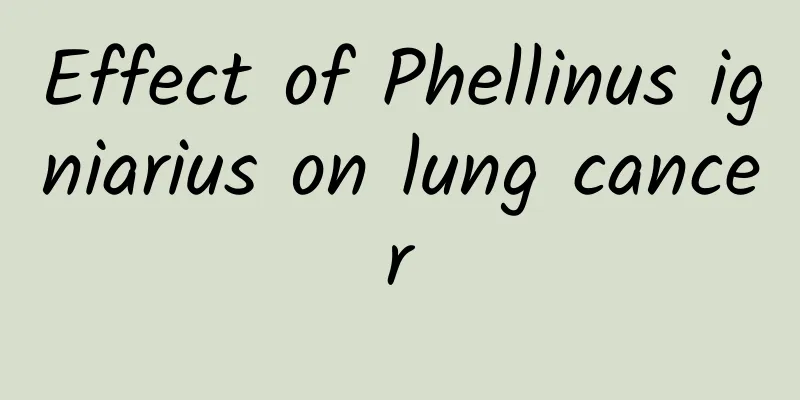Effect of Phellinus igniarius on lung cancer

|
To put it simply, Coriolus versicolor is the wild Ganoderma lucidum that grows on mulberry trees. When freshly picked, it is light yellow. Coriolus versicolor is only valuable when it grows on mulberry trees and is not easy to collect. Birch, pine, cypress and poplar trees also grow yellow, but they are poplar yellow, pine yellow and birch yellow, not mulberry yellow. Phellinus igniarius is a black fungus that grows epiphytically on mulberry trees, parasitic on mulberry trees with a crown diameter of 20-30 years and ancient broad-leaved trees. Once it parasitizes the host, it will digest and absorb all the nutrients of the host, causing the host to slowly wither. It is not difficult to see that it is very energetic. Wild Coriolus versicolor is rare and even more difficult to cultivate artificially. It grows very slowly, only growing 10 cm in three years. 2. The important discovery of the efficacy and function of mulberry yellow The application of mulberry yellow in my country has a history of more than 2,000 years since the Han Dynasty. "Compendium of Materia Medica" records that mulberry yellow can promote diuresis, strengthen the stomach and digestion, treat diarrhea and gynecological diseases. Its cancer-suppressing effects and functions were discovered in recent years, with 1968 being a turning point. The Department of Chemistry of the Cancer Research Laboratory of the National University of Japan conducted a clinical experiment, transplanting 180 types of tumor cells into mice. The results showed that the inhibition rate of Coriolus versicolor on tumors reached 96.7%. This discovery shocked the world and triggered a global research and development trend. At present, in Japan and South Korea, Coriolus versicolor has been widely used to treat various stages of cancer and prevent the metastasis and recurrence of postoperative cancer. Coriolus versicolor is used together with cancer drugs to enhance the effectiveness of cancer drugs, alleviate the side effects of chemotherapy and radiotherapy, and improve the quality of life of patients. 3. Phellinus versicolor ranks first in the field of microbial cancer treatment. Phellinus versicolor is a medicinal bacterium with excellent medicinal efficacy in the field of microbial cancer prevention recognized internationally. Its anti-cancer effect is much better than that of wild Ganoderma lucidum, Cordyceps sinensis, Dendrobium candidum, and Garlic antler. It can not only prevent cancer, but also alleviate the side effects of anticancer drugs. It can be used to assist cancer patients in radiotherapy and chemotherapy, and has become a hot spot in the field of medicinal bacteria research. There are six experimental certifications: Phellinus igniarius pl-8 has strong anti-tumor, anti-allergic and antioxidant specificity, and is the only anti-cancer herbal medicine with available data at this stage. 4. Why can Coriolus versicolor prevent cancer? The protein sugar, triterpenes, flavonoids, polysaccharides and other extracts contained in Coriolus versicolor have strong anti-tumor, anti-allergic and antioxidant properties, can lock cancer and enhance human immunity. It also produces a therapeutic effect against cancer by activating the human immune system. Therefore, it is non-toxic and harmless to the human body, and there will be no side effects even if taken in large quantities for a long time. Phellinus igniarius is often the best among all, not only because of its high sugar content, but also because of its unique composition ratio is superior to other microorganisms. It also has very good effects on some inflammations, such as gout, rheumatoid arthritis, allergic inflammation and other difficult diseases. 5. The main characteristics of Phellinus igniarius in preventing and treating cancer (1) Prevent sudden changes. Strengthen immune capacity and induce autonomous death of tumor cells; (2) Anti-cancer. Prevent ulcers, polyps, benign tumors, etc. from deteriorating into cancer; (3) Anti-migration. Inhibit the proliferation and migration of cancer cells; (4) Prevent attacks. Prevent the onset of cancer. (5) Relieve pain. Alleviate cancer patients' unique symptoms such as pain, poor appetite, fatigue, etc., and improve their quality of life; (6) Alleviate side effects. Relieve the side effects of chemotherapy and radiotherapy. |
<<: Side effects of magnolia flower
>>: The efficacy and function of white ganoderma lucidum
Recommend
The efficacy and function of Zoujiao
Traditional Chinese medicine is the quintessence ...
Give the tea tree a massage and it will give you its fruits!
When it comes to oil-tea, the first thing that co...
The efficacy and function of cassia root
Since Chinese medicine has fewer side effects, mo...
The efficacy and function of wild arrowhead
Wild arrowhead is very familiar to everyone. It h...
The efficacy and function of single whip
There are many common Chinese medicinal materials...
What are the effects and functions of mountain conch
Speaking of mountain conch, many friends may mist...
The efficacy and function of Doubanxiang
Doubanxiang is a very good medicinal ingredient. ...
The efficacy and function of hemp grass root
After thousands of years of sedimentation and acc...
The efficacy and function of golden cauliflower
Traditional Chinese medicine is a Chinese traditi...
The effect of drinking Jiaogulan
There are many aspects to the benefits of drinkin...
Abacus: It is expected that one-third of global flight traffic will come from Asia in 2025
Although the growth rate of air passenger traffic...
The efficacy and function of Xing'an Cimicifuga
As the pressure of modern life increases, more an...
A beam of light takes 1.3 billion years to reach Earth. How far has it traveled? How far is the light source from us now?
This article is based on answering a question fro...
How to use AED and seize the golden 4 minutes of "sudden death rescue"?
On the evening of June 30, a young athlete from t...
Can foodies eat up all the invasive species? Don't overestimate the ability of foodies
Recently, the topic of invasive species has frequ...









